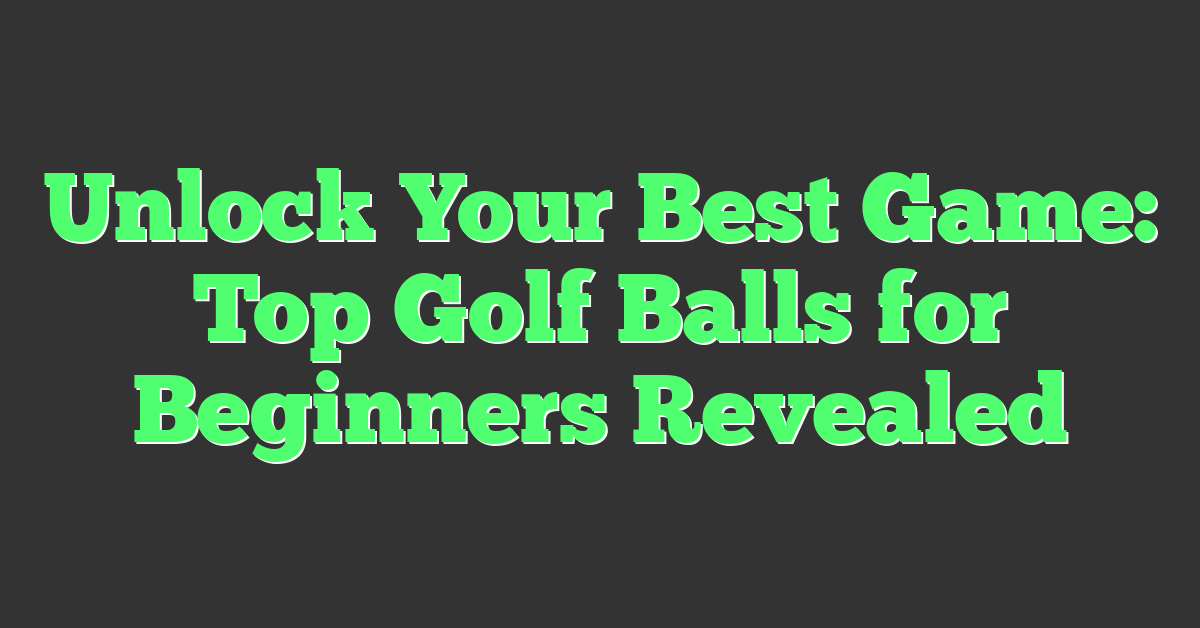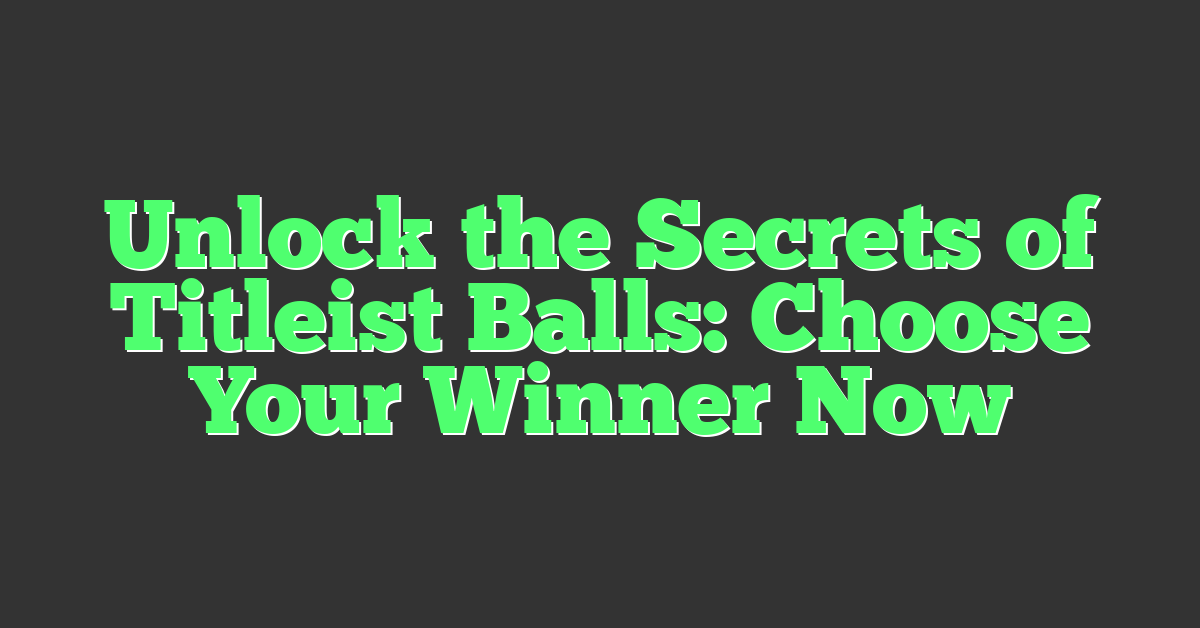Starting your golf journey can be as exciting as it is daunting. With a myriad of choices, picking the right golf ball is crucial to your game. You’ve probably wondered if the ball really makes a difference for a beginner. Spoiler alert: it does!

Choosing the right golf ball can help you improve your distance, control, and overall enjoyment on the course. As a beginner, you’ll want a ball that forgives your mishits and enhances your developing skills. Let’s dive into what makes a golf ball beginner-friendly and how to select the best one for your game.
Importance of choosing the right golf ball for beginners
You might not think that the golf ball you play with has a significant impact on your game, but as a low handicap golfer who’s been playing for years, I can assure you it does. When you’re just starting out, picking the right golf ball is as crucial as having the proper clubs.
Beginners need a golf ball that prioritizes distance and control. With the array of choices on the market, it’s easy to get caught up in high-tech features designed for more advanced players. However, those features won’t necessarily help your game right now. What you need is something that’ll forgive off-center hits and boost your confidence as you learn.
Low-compression golf balls are often recommended for beginners. They require less force to compress and therefore can travel further even with slower swing speeds typical of new players. This means you’ll see better distance in your shots, which is a great motivator on the course.
Spin is another aspect to consider. Beginners usually struggle with unintentional slice or hook, which can be quite demotivating. A ball with lower spin can reduce these side spins, helping to keep your shots straighter. While you might not get the same greenside control as with a high spin ball, at this stage in your development, accuracy off the tee and from the fairway is more important.
Durability is something you shouldn’t overlook. As someone who’s played countless rounds, I’ve seen many beginners lose balls to scuffs and water hazards. Starting with balls that can handle a few bad hits without looking like they’ve gone through a battle will mean you’re not switching out your ball every other hole.
When looking for your ideal beginner golf ball, remember to pair these features with a price point that suits your budget. There’s no need to splurge on premium balls at this stage of your game. What you need is a ball that provides the best balance between performance, forgiveness, and cost.
Key factors to consider when selecting a golf ball for beginners
When you’re starting out in the game of golf, selecting the right equipment can make all the difference in your development and enjoyment of the game. It’s about finding the right tools that work with your skill level to improve your gameplay. With golf balls, there are several key factors you’ll want to consider before making a purchase.
Construction is one of the most critical aspects you should look into. Golf balls can be categorized mainly by the number of layers they have, ranging from two-piece balls to multi-layered options.
- Two-piece golf balls are typically best for beginners. They’re designed to achieve maximum distance and are more durable, which means they can survive those occasional mis-hits.
- On the other side, multi-layered balls, which provide more spin and control, are generally suited for players who have developed their swing and want more precision on the green.
Another important factor is the compression rating of the golf ball. Low-compression golf balls are softer, meaning it’ll be easier for you to compress the ball at impact even with a slower swing speed, which is common among beginners.
- Balls with compression ratings of 80 or less are often recommended for beginners.
The feel of the ball is also something that beginners should take into account. As you’re building your skill set, you’ll want a ball that provides feedback with every shot, helping you to better understand your game.
- A softer feel typically indicates a better response, especially around the greens, but it shouldn’t come at the expense of distance.
Lastly, consider the price of the golf balls. As a beginner, you’re likely to lose more balls as you learn the nuances of the game. Therefore, be mindful not to invest heavily in premium balls right away. Look for balls that offer a good balance between quality and affordability.
Remember, there’s no one-size-fits-all when it comes to golf balls, but these guidelines should steer you toward options that’ll enhance your game at this early stage. Experiment with different balls to find the one that feels right for you. As you develop your skills and gain experience, your needs may change, and so might your choice of golf ball. Practice, play, and pay attention to how each type of ball affects your performance on the course.
Understanding the construction of golf balls for beginners
As you delve deeper into the world of golf, you’ll realize that the construction of a golf ball significantly influences your game. For starters, the core is the heart of the golf ball. It’s what determines the compression and ultimately how far the ball will travel. As a beginner, you’ll benefit from a softer core, which complements slower swing speeds and provides greater distance.
The cover of the golf ball is another critical component. Typically made from Surlyn or urethane, the cover impacts the ball’s durability and control. Surlyn-covered balls are more durable and resist cuts, making them ideal for beginners who are still perfecting their swing. On the other hand, urethane covers offer more spin and feel but tend to be less forgiving.
Looking at the layers, you’ll come across two main types of golf balls:
- Two-piece construction: These balls comprise a solid core and a durable cover. They’re designed for maximum distance and durability, perfect for new golfers still mastering control.
- Multi-layer construction: More advanced balls may add extra layers. These layers work together to offer a nuanced game through better spin control and feel. While enticing, these are generally better suited for players with a stronger command of the game.
The dimple pattern on the golf ball is not just for show; it’s an engineered design to aid flight stability and reduce air resistance. While the specifics can get quite technical, remember that a uniform dimple pattern contributes to a predictable flight path, something you’ll appreciate as you learn to shape your shots.
Choosing a golf ball as a beginner doesn’t have to be overwhelming. Start with a two-piece, low-compression ball that maximizes distance and forgiveness. Pay attention to how different constructions affect your play. Remember, your golf ball is your partner on the course, and finding the right one is a step towards consistently lower scores.
The importance of forgiveness in golf balls for beginners
As you delve into the world of golf, you’ll discover that forgiveness in a golf ball is just as crucial as the warmth of the sun on the fairway. Forgiveness refers to a ball’s ability to minimize the effects of poor swings or off-center hits. For beginners like you, this is especially important. It can mean the difference between a shot that veers wildly off course and one that still makes it onto the green.

Forgiveness Factors in Golf Ball Design
What makes a golf ball forgiving? Let’s break it down:
- Low Compression: Golf balls with a low compression allow for better deformation at impact. Basically, they squash more. This means your slower swing speeds can still generate significant distance.
- Large Core: A larger core in a two-piece golf ball tends to result in lower spin rates. Less spin on your mishits means the ball won’t curve as much, helping to straighten your shots.
- Dimple Pattern: Just like the stability it lends as discussed earlier, a well-designed dimple pattern can help maintain ball trajectory even on less-than-perfect hits.
Choosing a forgiving golf ball is not about masking your mistakes but rather giving you a chance to enjoy and learn the game without the added frustration of an unforgiving ball.
Real-World Impacts on Your Game
Let’s talk about what this forgiveness means for your game:
- Improved Confidence: Knowing your ball is designed to be forgiving can boost your confidence, making you more at ease when taking a swing.
- Enhanced Learning: With fewer wild variations in where your ball ends up, you can better understand your true swing mechanics and areas to improve.
Remember, a forgiving golf ball will not magically correct all your mistakes—it’s a tool that supports your journey as you develop your skill set. Just like the proper selection of clubs, the right golf ball can enhance your learning curve and lead to more consistent play. Now, as you practice, focus not just on the ball itself but on how it interacts with your unique swing. Observe, learn, and adapt.
Comparing different types of golf balls for beginners
When you’re starting out in golf, the plethora of golf ball options might seem overwhelming. Knowing the key differences can make all the difference in both performance and enjoyment on the course. Let’s break down the main types of golf balls you’ll encounter.

Two-Piece Golf Balls are the most popular for beginners. They usually have a durable outer layer, known as the cover, and a large, solid core. This design promotes distance and is generally more forgiving of mishits, which is crucial when you’re learning the ropes.
- Advantages:
- Greater durability
- More distance off the tee
- Reduced spin (lessens the impact of slices and hooks)
Multi-Layer Golf Balls, typically three- or four-piece, are constructed to offer seasoned players more control and spin. While you might be tempted to play what the pros use, these balls require a higher skill level to fully exploit their potential. As a beginner, they could actually hinder your game more than help.
- Advantages:
- Enhanced spin control
- Better feel around the greens
- Customizable performance based on the ball’s construction
For beginners, it’s less about the branding and more about the ball properties that match your current skill level. If your swing speed is on the slower side, look for balls with lower compression; they tend to be softer and can provide a helpful distance boost. Alternatively, if you’ve started to develop a faster swing, a slightly higher compression ball may give you additional control as you hone your technique.
Here’s a quick reference for the predominant golf ball types:
| Type | Core | Layers | Spin | Compression |
|---|---|---|---|---|
| Two-Piece | Large | 2 | Low | Low |
| Multi-Layer | Smaller | 3 or 4 | High | Medium-High |
Tips for selecting the best golf ball for beginners
When you’re just getting into golf, the vast array of equipment can be overwhelming. Choosing the right golf ball is as crucial as selecting your clubs, so let’s simplify the process.

Firstly, understand your swing speed. It’s tempting to go for what the pros use, but your swing might not be there yet. Most beginners have a lower swing speed, which suits a low-compression ball. These balls are softer and can help you to achieve greater distance.
Next, consider durable two-piece construction. As you’re developing your game, chances are you’ll lose a few balls to water hazards and the rough. Two-piece balls are not only cost-effective but they also withstand mis-hits better than the higher-priced options.
Prioritize visibility. Learning to track your ball in flight is easier when it’s brightly colored. Yellow and orange golf balls are popular for their standout hues, especially in overcast conditions or on a course with lots of foliage.
Don’t overlook feel. Even as a beginner, a ball that feels good off the club can improve your confidence. You’ll want to try out several types to get a feel for what’s comfortable for you. Some driving ranges have practice balls from different manufacturers, so take the opportunity to experiment.
Here are a few characteristics to keep in mind:
- Swing Speed: Low to moderate
- Construction: Typically two-piece
- Visibility: Bright colors (yellow, orange)
- Feel: Personal preference
By focusing on these points, you’ll be better equipped to find a golf ball that suits your beginner skill level and helps enhance your enjoyment of the game. Remember to test different balls in real-world conditions and don’t be afraid to ask for advice at your local pro shop. Keep it up, and you’ll find your perfect golf ball that’ll help drop those extra strokes off your game.










